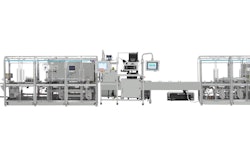
The global frozen food market size is expected to reach $380.5 billion by 2027, expanding at a CAGR of 3.4%, according to a new report by Grand View Research, Inc. Convenience, year-round availability, long shelf life and comparable health benefits to fresh produce are some of the factors spurring growth.
However, maintaining safety and quality in frozen foods is a delicate process that involves the entire frozen food cold chain—pre-treatment, processing, packaging, frozen food storage, transport and thawing food. In every step of frozen food processing, maintaining proper hygiene, preventing foreign matter intrusion and deterring microbial growth are of the utmost importance. As such, many processors are reconsidering the use of “open” conveying systems such as bucket elevators and flat-belt conveyors in favor of enclosed systems designed to prevent exposure to ambient conditions and possible contamination.
Additionally, as frozen food processors seek to increase production uptime and reduce laborious maintenance, the ease of cleaning such equipment is also a major concern.
While the frozen food industry has some of the highest food safety standards in the nation, many producers tend to neglect the conveyor systems used to transport frozen foods through the facility. These systems should not only adhere to all the safety and quality standards of other freezing and packaging equipment, but also maximize throughput speed to efficiently transport products and prevent unwanted thawing.
In frozen food production, line changeovers have become a focal issue, relative to both cleanliness and changeover speed as companies are increasingly running different product lines within a single shift or day. Despite these changeovers, processing plants are expected to maintain rigorous levels of sanitary, allergen-free operation.
So, to ensure the safe, clean conveyance of produce with minimal product degradation, a growing number of frozen food processors are turning to enclosed systems such as tubular drag conveyers that help prevent contamination and significantly ease, or even automate, cleaning.
The disadvantages of open conveyor systems
Traditionally, bucket elevators and flat-belt conveyors have been the predominant systems used to transport food products. However, open systems like these have substantial drawbacks in terms of the potential for contamination and ease of cleaning.
Bucket elevators utilize a continuous line of buckets, either attached to each other on a rubber belt, or attached by pins to two endless chains running over tracks and driven by sprockets. Centrifugal force moves the food being conveyed out of the buckets into a discharge spout as the buckets pass. This type of conveyor handles food products gently, but potentially exposes it to contamination from the surrounding environment.
Flat-belt conveyors have the same issue, and so some are covered. Unfortunately, the covers can collect residue and must be removed and cleaned between runs, a tedious and time-consuming task.
In most frozen food applications, bucket elevators and/or open conveyors such as belts can result in significant product spillage and warming, leading to serious quality and efficiency concerns.
Open conveyors also allow the product (if hygroscopic) to absorb moisture. Such moisture absorption can cause product to expand, or clump; this can degrade quality as well as make conveyor cleanup more difficult.
The advantages of closed conveyor systems
Unlike open systems, closed conveyor systems effectively seal off product from the outside environment and potential contamination from that source.
Although there are several types of closed systems, one popular example when conveying high value foods that are prone to degradation is tubular drag cable conveyors. These systems gently move product through a sealed tube using a coated, flexible stainless-steel drag cable pulled through on a loop. Solid circular discs (flights) are attached to the cable, which push the product through the tube without the use of air. The coated cable ensures that no debris accumulates within the strands of the cable, as the cable is totally sealed.
The enclosed nature of tubular drag systems ensures no dust escapes: that could lead to an unsanitary and potentially dangerous coating of dust on the floor or process equipment. The result is a safer, cleaner, dust-free work environment.
In the frozen food industry, tubular drag cable conveyors are utilized for products such as blueberries, broccoli, carrots, peas, hash brown patties, as well as chicken. The systems can convey up to 2,000 cubic feet per hour of frozen produce items with numerous layouts using multiple inlets and outlets.
Materials used in the construction of these systems include alloy 304 stainless (optional 316 stainless) with sloping surface capabilities and food-contact grade engineering plastics, including clear tubing. These types of conveyors help reduce the incidence of black specks occurring on the product, which is a big quality concern when it comes to other types of conveyors. Tubular drag cable conveyors also eliminate the issues of product spillage and warming, which is often a problem with system types such as buckets, pneumatic, screw augers or belt conveyor systems.
In addition to avoiding external contamination, frozen food processors also increasingly expect conveyor systems to be designed for easy cleaning.
In this regard, bucket elevators are particularly difficult to clean in preparation for production line changeovers. To clean them, each bucket must be removed and cleaned inside and out to remove accumulated residue.
With closed conveyors, cleaning is also a mixed bag. Pneumatic conveyors are popular, enclosed systems, but cleaning can still be relatively time consuming. Because high pressure air is used to convey product, it can create excessive breakage as materials get battered through a course of vertical and horizontal tubing, turns and sweeps.
In regard to maintaining cleanliness, tubular drag cable conveyor systems also offer more options for dry and wet tube conveyor cleaning. These include brush boxes, urethane wipers, air knives, inline sponges, inline bristle brushes and multi-step, essentially automated clean-in-place (CIP) wet cleaning.
Cleanliness is also a key consideration when selecting between cable and chain tubular drag conveyors, both of which come into contact with the food during operation. Tubular chain conveyors have more surface area and connection points where residue can accumulate compared to a coated cable, which only has 20% of the surface area.
Minimizing product breakage is another important advantage of enclosed tubular cable conveyors. Traditional conveyor systems can damage up to 10% of product, but tubular cable conveyors dramatically reduce any such damage.
Although there are many conveying options for frozen food processing, few offer the same capability of preventing contamination and easing cleaning as closed system tubular cable conveyors, while also minimizing product degradation. This combination of attributes makes the conveyors worth investigating for food industry professionals looking for a competitive edge.

















